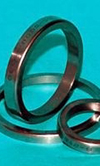Valve seat materials
 In a four-stroke race engine, the valve seats play an important part in the mechanical reliability and heat management of the valves. In general, the valve seat will conduct much of the heat away from the valve head during the time the valve is shut. If we leave mechanical and dimensional considerations aside, a valve seat material with greater thermal conductivity will transfer heat from the valve to the cylinder head, and thence to the cooling water circuit, more efficiently than one of lower thermal conductivity.
In a four-stroke race engine, the valve seats play an important part in the mechanical reliability and heat management of the valves. In general, the valve seat will conduct much of the heat away from the valve head during the time the valve is shut. If we leave mechanical and dimensional considerations aside, a valve seat material with greater thermal conductivity will transfer heat from the valve to the cylinder head, and thence to the cooling water circuit, more efficiently than one of lower thermal conductivity.
Where hollow-stemmed valves are filled with a liquid metal, the main mechanism of heat transfer from the head of the valve may no longer be through the seat, and in these cases the choice of seat material is not of such critical importance thermally.
In general, bespoke race engines will have valve seat inserts fitted and machined in situ. There have been attempts in racing to used sprayed valve seats, where the seat material is plasma-sprayed onto a prepared head and then machined back to the correct form. For small quantities this process is extremely costly, although for large production quantities (as in manufacturing road vehicles) it is increasingly common and is an economical process.
The most common materials used for making valve seats for bespoke race engines are copper alloys, as mentioned in an earlier RET monitor article about copper alloys. They have excellent thermal conductivity, good wear characteristics and reasonably high strength. Copper beryllium alloys that contain small additions of beryllium are commonly chosen for race engines, with those who specialise in seats offering them as 'A3 alloy' or 'A25 alloy' seats, although beryllium-free alternatives such as Moldstar 90 and Moldstar 22 are gaining in popularity in racing. As you might conclude from the name Moldstar, such alloys (and also beryllium copper alloys) are commonly used for manufacturing mould tooling, where conductivity is also a highly desirable property.
So, apart from these materials, what else could we consider? Well, many people persevere with the production valve seat materials for production-based race engines. Cast-iron heads had the seat machined directly into them, so such cast-iron materials can be considered as candidates for seats, as can steels.
White cast-iron inserts, which are very hard, have also been used in production vehicles, as have powder metallurgy steel materials. A number of companies offer these powder metallurgy materials and finished seat inserts for sale. They range from steel 'pre-forms' that are infiltrated with copper alloys, to a tool steel matrix infiltrated with graphite-containing iron alloys.
Beyond this, and into the realm of more exotic materials, some silver alloys are attractive because of their high thermal conductivity, but less so from the point of view of strength and the fact that parts may 'go missing' from stores. With precious metals at a premium at present, and likely to remain so, this is perhaps not the time to be looking at fitting silver-based alloy seats to your engine!
Fig. 1 - Powder metal materials are a possible choice for race engine valve seats
Written by Wayne Ward